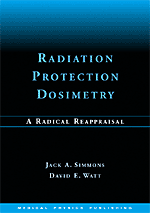
Radiation Protection Dosimetry: A Radical Reappraisal
Author: Jack Simmons & David WattISBN: 9780944838877 ISBN10: 0944838871
Published: 1999 | 160 pp |
OUT OF PRINT
Radiology | August 1999
“Simmons and Watt are radiation physicists who propose a new injury model based on fluence, where fluence describes the number of charged particles that traverse a specific biologic target such as a DNA molecule.
“Since mostly x-rays, gamma rays, and electrons (low linear energy transfer [LET] radiation) are used in radiation medicine, the fluence here describes the secondary electrons of primary ionizations. The biologic target size (where the injury occurs) can be described as a cross section. The probability of injury is then determined by multiplying the fluence by the biological cross section. This model is simple in its construction, but it is not simple in its implementation. Cross sections vary with the biological end point considered. They depend on the density of ionization caused by the charged particle fluence. Both low LET radiation and high LET radiation are addressed.
“The authors believe their model unifies experimental and epidemiological observations for both types of radiation. They address the well-known dependence of injury on dose rate or fluence rate (flux) with a time-sensitive ‘repair factor.’ This is especially important for low LET radiation.
“The authors argue that absorbed dose (in rads or grays) does not provide a sound basis for studying the effects of radiation injury. Introducing ‘quality factors’ and ‘distribution factors’ to modify dose (in rems or sieverts) does not fix the problem. They conclude that this effectively invalidates the linear, no-threshold model of injury. Could a concept as widely accepted as the linear, no-threshold concept be wrong? The authors note that science sometimes requires ‘a fundamental reconsideration of ... acceptable concepts.’ There is evidence that it is time for reappraisal of scientific beliefs regarding radiation injury.
“Simmons and Watt conclude that for mammalian cells, injury is most critical when ionization events occur at spacings no greater than 2 nm. This roughly corresponds to the distance between strands of the double-helix DNA molecule and is likely the spacing at which double-strand breaks begin to occur. The 2 nm spacing can occur with a single high LET particle transversing a target, but, for low LET radiation, there is substantial occurrence of this spacing only when more than one primary charged particle interacts with the same biological target. Low doses and/or low dose rates of low LET radiation may not cause injury because there is not enough charged particle fluence to cause unrepaired double-strand breaks.
“This is an important and timely book. It contains descriptions of the models used today do describe radiation injury. There are chapters on the history and evolution of radiation protection policy by the International Commission for Radiological Protection and the International Commission on Radiation Units and Measurements. Policy positions that are not linked to science are identified.
“The book can be read in a night, but it will take longer to understand. Concepts are evolving and difficult. Are the authors correct in their beliefs? I don’t know. But like bold scientists of yesteryear, they have nailed their propositions on the ‘doors of the institution of science.’ We will decide to either excommunicate them as scientific heretics or to embrace their proposals as having scientific merit. You will enjoy this book. Most will not understand all of it (I certainly did not), but you will feel enriched if you spend some time considering the author’s beliefs and proposals.”
David S. Gooden, Ph.D., J.D.


